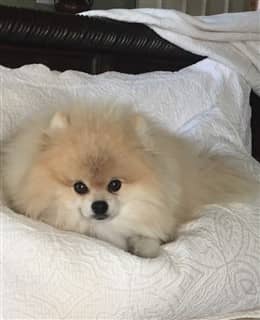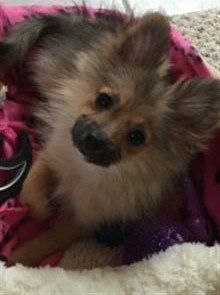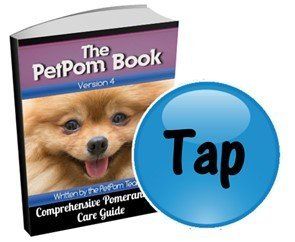How to Resolve Itching Issues with a Pomeranian
Overview
It’s really hard to watch a Pomeranian be super itchy; it’s clearly uncomfortable for the puppy or dog, and you’re not alone if you’re having trouble figuring out what’s causing the problem.
A Pom that is itchy can be constantly scratching, and both skin and coat are often affected. Some Poms will scratch so much that the skin breaks open, causing further secondary issues.
Itching may be limited to just one part of the body such as the armpits, groin, base of the tail, ears, or paws, or it can be an all-over body problem. You may have tried products that helped, but only to some degree. And in many cases, even had a vet prescribe some medications that only partially worked.
Issues with itching can occur with Poms of any age, and it’s not uncommon for this sort of problem to be seen with adult Pomeranians that had no previous issues at all.
While you may need to do some work to find the root cause of the itching, there is help to resolve this. This section will cover what you need to know and steps to help your Pom stop scratching for good.
Please note:
PetPom is reader-supported, and some of the product suggestions on this page are affiliate links. As an Amazon Associate we earn from qualifying purchases. This is at no extra cost to you and helps us continue providing free, high-quality information.
Summary of How to Help
There is help for Pomeranians that are always itchy; you will want to:
1. Determine possible causes including fleas, allergies, dry skin, and yeast infection. Do not delay bringing your Pomeranian to the vet to help diagnose the issue.
2. Take steps to resolve the issue, following every guideline that is applicable including seasonal care
changes and home environment adjustments.
3. Use a topical spray and specialized shampoo to offer immediate relief.
4. Offer supplements or additional aid via lotions if needed.
5. Use quality shampoos, conditioners, and coat sprays to keep problems at bay.
Issues Seen Along with Itching
While your Pom may be scratching or chewing at himself without any other signs or symptoms, typically there is at least one of the following happening, and sometimes several:
• Bad odor, even right after a bath
• Thinning coat or losing fur to the point of bald patches (this may be due to intense scratching or due to the underlying issue)
• Rash or bumps
• Scabs on the skin
• Red, irritated skin
• Signs of stomach upset including decreased appetite or vomiting (not overly common, but can be seen with dogs that are suffering from food allergies)
Top 5 Reasons for Excessive Itchiness & Steps to Cure It
Please note:
Do not automatically discount these possible issues; you may be surprised at some of the signs.
#1 Fleas
Owners often discount this if they do not see fleas swarming around their Pomeranian, or if the Pom is almost always inside and therefore not ‘able’ to catch them. But, even if your Pomeranian is itching without any immediate signs of fleas, it is always worth investigating this a bit further to be sure.
Here’s 3 things to know:
1.
It’s very easy for a dog to catch fleas, even if both the dog and the house are kept clean.

Small black specks about the size of a pencil tip are flea droppings, commonly referred to as flea dirt. This may be all that you see, since fleas can move incredibly fast, crawling or jumping out of the way before you can spot them.
The fleas themselves are often the size of 1/2 grain of rice and are brownish-red. If you do see one flea, there are likely hundreds more.
2.
Inspect the house.
To confirm fleas as the cause of itching, you may want to check your home as well. If fleas have been on a dog for more than a few days, most likely they are also in the house. These will be on your Pom’s bed, on carpeting where your Pom rests, or throughout other furniture in the house.
One method is to take a white paper towel and run it over a rug; if you then see tiny red specks, this is the blood from fleas that you’ve just killed.
3.
If you are still not sure, do not hesitate to have your veterinarian inspect your Pom.

Sofie, photo courtesy of Ana Resillez
4.
Treat your Pom and your house for fleas.
Beware of harsh flea dips; some of these are chock-full of chemicals that can cause terrible reactions. Instead, we recommend an effective all-natural product.
One that works very well is Vet's Best Natural Flea and Tick Spray
 (also see below); this is a plant-based spray that kills fleas both on a dog and in the house, and kills flea eggs. It contains safe ingredients including peppermint oil and an oil made from clove plants called eugenol.
(also see below); this is a plant-based spray that kills fleas both on a dog and in the house, and kills flea eggs. It contains safe ingredients including peppermint oil and an oil made from clove plants called eugenol.
Along with this, you’ll want to use a good flea comb. You can pour some of the flea spray into a bowl, mixed with a bit of water and dip the comb in… or part the fur and spray by section. Comb your Pom very carefully, being sure to reach down to skin level, and slowly making your way over every area of the body. Dip the comb in the bowl after each swipe.
Then, be sure to blast away the fleas in the house. Don’t hold back with this stuff, it typically does not stain materials.
Vet’s Best also makes a great flea wipe, which you can use on your Pomeranian as a grooming wipe or to use as a cleaning cloth in the house.
5.
Once the fleas are gone, use a flea prevention product. You may wish to steer clear of chemicals, and if so, there are some good natural choices like Curealia's Pure Natural Insect Repellent for Dogs
 (also see below).
(also see below).
Next, we will cover the 4 other top reasons why a Pomeranian may be itchy and follow that with products to help soothe things and help a Pom recover from an exhausting bout of scratching that has affected both skin and coat.
#2 Allergies
What’s happening:
Many dogs are affected by some type of allergy
by varying degrees, and this can be tricky because there can be more than one trigger, a Pom can suddenly develop allergies after years of being okay, and even vets can be baffled by the cause. In many cases, topicals or medications only work to some degree or just temporarily.
Any type of allergy (food, environmental, contact) can cause itching. A Pomeranian may have itching sensations everywhere, but focus his scratching or chewing on just one area of the body; this is often the paws since they are easily accessible. If other areas are itchy, such as the groin or head, the Pom may rub his body against objects in an attempt to scratch them.
Often, some type of skin irritation will be present. This may be tiny bumps, a rash, and/or raw skin.
In some cases, prolonged or severe issues may affect the coat; it may be thinning and/or the texture may be poor.
What to do:
1. Veterinary examination and testing.
While many owners want to be able to cure their Poms at home, moderate to severe allergies often need to be treated by the vet. Testing can be done to determine the triggers, which is a huge step in decreasing or eliminating them. In addition, medications including antihistamines and/or anti-inflammatories can be prescribed.
2. Reassess foods.
In many cases, it is chemical additives that are causing the problem. Artificial coloring, flavoring, or chemical preservatives can cause terrible reactions. In addition, a dog can have trouble with high levels of grains, by-products, or fillers.
You’ll want to feed your Pom a top rated 100% all-natural kibble that contains zero additives. Wellness Complete Health for Toy Breeds
 is a good choice for this; it is one of our top recommended brands.
is a good choice for this; it is one of our top recommended brands.
If you suspect an allergy to a certain protein such as chicken (very rare, but possible), consider switching to a kibble with a different protein base. Merrick Lil Plates Grain Free Small Breed Recipe
 is a high-quality food that offers lamb, salmon, or beef based formulas.
is a high-quality food that offers lamb, salmon, or beef based formulas.
3. Clear the home of allergens.
If you have central air, run the AC or fan while using HEPA filters. If you do not, consider a free-standing air purifier. Vacuum all flooring (hardwood and carpeting) with a HEPA certified vacuum cleaner. Wet dust the house often. Keep windows closed.
4. Keep allergens off your Pom. During spring and summer months, check weather reports to try and avoid heading outside during times of high pollen counts.
In addition, every time your Pom enters back into the home, wipe their body down with a quality grooming wipe like Earthbath All Natural Grooming Wipes
 and rinse the paws off in the sink.
and rinse the paws off in the sink.
5. Offer anti-itch relief.
Use products to offer immediate itching relief and shampoos to help with healing and restoring. For full details on this, look to our section below on Products to Soothe and Treat Itching.
Next, we will cover the 3 remaining top reasons why a Pomeranian may be itchy, and follow that with a full list of topicals and other products to help a Pom find relief.
#3 Fungal/Yeast Infection

Photo courtesy of Nicole Moon
Common signs:
One clear symptom of yeast infections is the strong, rancid odor that occurs with this. Some describe this as a dank musty smell, like old wet socks, or even like spoiled milk. A Pom may smell bad even right after a bath.
There may also be tiny bumps; after some time, these may develop further, becoming filled with pus. Scaling or crusting may develop. The skin may have a sheen to it, appearing oily.
What to do:
1. Have this properly diagnosed.
You’ll want to have bacterial skin infection ruled out since this requires treatment via antibiotics, and in some cases a dog can have both bacterial and yeast infections at the same time. This will also rule out other possible causes for itching including demodex and scabies.
The veterinarian will take a sample via swab or tape impression.
2. Anti-fungal shampoos.
A shampoo with chlorhexidine and ketoconazole is usually very effective for fungal or yeast infections. This is meant to be used as a topical treatment, so this needs to be massaged in and then left on for 10 minutes. Once those 10 minutes has passed, be sure to rinse this out very well.
A Pomeranian will often need these bath treatments every 3 to 4 days for at least 2 weeks, and in some stubborn cases, up to 12 weeks.
A good choice for this is Bexley Labs Curaseb Antifungal & Antibacterial Shampoo . This has the effective combination of chlorhexidine and ketoconazole, is made in the USA, and actually smells pretty nice with a refreshing cucumber melon fragrance. It also comes with a 100% guarantee.
. This has the effective combination of chlorhexidine and ketoconazole, is made in the USA, and actually smells pretty nice with a refreshing cucumber melon fragrance. It also comes with a 100% guarantee.
3. Prescribed medications.
In some cases of a very stubborn yeast infections, an oral anti-fungal medication will need to be given. These can have some side effects, so you’ll want to discuss this with your veterinarian.
#4 Dry Skin
If your Pomeranian is itchy, but does not have any other symptoms such as having a bad smell, a rash, or pustules, and there are no signs of fleas or other such issues, it may just be a matter of your Pom having dry, itchy skin.
Skin can get very itchy due to environmental factors, and the weather plays a big role. It’s very common for dogs to have issues in the winter
due to cold arid air. Summer is another time of the year when itchiness can occur due to the drying effects of the sun.
What to do:
1. Do be sure to rule out any other possible causes.
After all, in areas that experience 4 seasons, itchiness will be occurring in the winter or summer 50% of the time. So, you’ll still want to make changes to your Pom’s food if necessary, take steps to help resolve allergies, and have infections or parasites ruled out.
2. Ensure that your Pomeranian is staying properly hydrated.
Dogs need, on average 13 ounces of water for each 5 pounds of weight, daily. This amount can vary depending on the season, a dog’s activity level, age, and health status.
Encourage your Pom to drink by keeping the water bowl
super clean, not topping it off but completely refilling it several times a day, and using cool, filtered water. Always bring water along when you head out for walks.
3. Keep a good grooming routine.
Brush your Pom often to stimulate natural oil production, bathe your dog every 3 weeks, and use superior shampoos and conditioners like those in the Earthbath line (more ahead under Recommended Products).
4. Adjust care according to the season.
In the winter, use humidifiers if the air in the house is dry and place appropriate clothing on your Pom when you head outside for daily exercise. Though it’s recommend year-round, especially in the winter and summer apply paw wax like Musher's Secret
 to protect paws; this has many benefits including keeping paws from drying out.
to protect paws; this has many benefits including keeping paws from drying out.
5. Don’t let your Pom lie on just the floor.
Some Pomeranians do enjoy resting on bare floors; however, prolonged resting or sleeping on flooring, including carpeted materials, does not offer proper support and can cause contract friction. Choose a quality bed for your Pom; aside from cozy bolstered beds, flat mattresses are also an option.
6. Protect your Pom’s skin.
What can you do to help protect your Pom from harsh dry winter air? And guard against the drying effects of the sun? What about adding a layer of protection from contact friction which can irritate the skin, especially on the elbows?
The answer is to routinely use a leave-in conditioner spray. You’ll want to spritz this on the coat every 3 days or so. With puppies, you can spray this on a comb first, then go over the coat in sections. For adults, spritz 1/2 to 1 inch from the roots, then brush down to the tips.
You can choose a favorite one to use year-round like The Stuff , or additionally switch to one with a sunscreen just in the summer like Chris Christensen Ice on Ice Conditioner with Sunscreen
, or additionally switch to one with a sunscreen just in the summer like Chris Christensen Ice on Ice Conditioner with Sunscreen .
.
#5 Other, Less Common but Possible Conditions
While fleas, allergies, yeast infection, and dry skin are the top causes of itchiness, there are other less likely but possible reasons. This includes parasites such as mites, and health conditions
including canine diabetes and Cushings disease.
For this reason, if your Pomeranian has been itching for a while and steps to resolve this at home are not working, it is vital to bring your Pom to the vet for a full and complete checkup. Our dogs depend on us to protect and care for them, and a huge part of that is seeking professional care when issues cannot be cleared up at home.
Top Recommended Products to Soothe and Treat Itching
Though it took a while to get here, it was important to cover the ground we did, so that you understand the possible root causes of your Pom’s itching. After all, you don’t want to just put a Band-Aid on a much bigger problem. And while there are some fantastic remedies to prevent and treat itching, if the larger issue is not resolved, these will just be temporary fixes.
This said, let’s go over what can offer your Pom immediate relief and what can help heal skin that’s been through an exhaustive bout of itching and scratching.

Topical sprays:
A topical spray can offer a Pom quick relief of itching since this is applied directly to the sites of irritation. There are two different types of anti-itch sprays; medicated and all-natural.
A medicated anti-itch spray
can be a good choice for Pomeranians that are really suffering with intense itch and irritated skin. Hydrocortisone works to stop itching and lidocaine can offer pain relief.
A very effective one is SynergyLabs Clinical Care Itch Relief Medicated Spray ; this can be applied every 4 to 6 hours.
; this can be applied every 4 to 6 hours.
Certain all-natural anti-itch sprays
can be extremely effective as well. You may find that your Pom benefits from a medicated spray initially, and then as things improve you can transition to this type. Though, for many dogs the right spray can just about instantly stop even severe itching.
One that works very well is Bodhi Dog’s Anti Itch Oatmeal Spray which can be applied every 2 to 3 hours, with the last application right before a Pom goes to sleep.
Shampoos:
The right shampoo
can help since it will be a product that you can saturate your Pomeranian with to offer treatment to all parts of the body.
There are several types with varying formulas, however it may be hard to beat Moosh All Natural Shampoo
 which offers help in so many ways. This is a 100% organic, all-natural shampoo that contains bentonite clays which binds to skin toxins to draw them out and soothes skin. There is also neem and argan oil to add moisture. And there is shea butter and aloe vera which are excellent at healing and restoring skin.
which offers help in so many ways. This is a 100% organic, all-natural shampoo that contains bentonite clays which binds to skin toxins to draw them out and soothes skin. There is also neem and argan oil to add moisture. And there is shea butter and aloe vera which are excellent at healing and restoring skin.
Once your Pom’s itching has been relieved, it’ll be important to use quality shampoos going forward to help prevent future issues. The Earthbath Shampoo
 line of products is exceptional for this. They have several great formulas including Oatmeal and Aloe, which we recommend as a ‘regular’ shampoo, as well as Tea Tree Oil and Aloe Vera, and Eucalyptus and Peppermint which are both great for itching.
line of products is exceptional for this. They have several great formulas including Oatmeal and Aloe, which we recommend as a ‘regular’ shampoo, as well as Tea Tree Oil and Aloe Vera, and Eucalyptus and Peppermint which are both great for itching.
No matter which shampoo you choose for regular use, you can pair it with their conditioner which is an Oatmeal and Aloe.
Additional Aids to Soothe Itching and Promote Healthy Skin and Coat
With Pomeranians that have endured prolonged or intense itching and scratching, this can really take a toll and it can take some time to recover. Skin may be raw or overly sensitive.
And since skin and coat go hand-in-hand, it is very common for a Pom’s fur to thin out. Of course, you’ll want to rule out fur issues
that may be affecting the coat, including black skin disease. However, if the coat is in poor condition due to itching that has been resolved, there are some things you can do to help.
Fish Oil Omega 3 Supplements:
Fish oil is a rich source of Omega 3. This is an essential fatty acid, which means that the body cannot produce it; it must be obtained via the diet. High quality kibble
will have good levels of omega; but for times like this, extra supplementation can be very helpful.
A healing lotion can work well in two ways; just massaging your Pomeranian can increase blood flow and stimulate hair follicles, and doing this with soothing and healing ingredients can offer fast relief.
One that has works exceptionally well is ResQ Organics Pet Skin Treatment . This can cure a wide range of issues; it works on burns on paw pads from hot walking surfaces, itchy insect stings, excessive dry skin, allergy-related itchiness, and more.
. This can cure a wide range of issues; it works on burns on paw pads from hot walking surfaces, itchy insect stings, excessive dry skin, allergy-related itchiness, and more.
Massage this onto trouble spots 1 to 3 times per day. Don’t rush this; do this in a quiet spot, taking your time. Many dogs do enjoy this sort of care as it can be very relaxing. Then moving forward, you can use this every few days, then every week to maintain things.
A Final Word
It’s always hard to watch our Poms suffering with an issue, especially a chronic problem like itching. It really does take a toll, both physically and emotionally. Don’t be surprised if your Pom sleeps more once treatment starts working, the relief that a dog feels after being freed from scratching all day can let a dog finally relax and catch up on his rest.
And remember that while many issues can be remedied at home, never delay seeing the veterinarian if symptoms worsen or if your Pom does not fully improve.
You May Also Like:
How to Remove Tear Stains on a Pomeranian
- If your Pom has developed reddish brown discoloration around the eyes, there are some methods to remove this.
How to Keep a Pomeranian Clean
- The top 9 tips for keeping a Pom looking tidy and smelling fantastic.
Best Snacks for a Pomeranian
- What your Pom eats for treats is just as important as main meals, and you should be just as choosy for what you decide to offer.
Best Brushes to Use on a Pomeranian
- With this breed that has a thick double coat, you'll want to be sure to use the right grooming tools.









